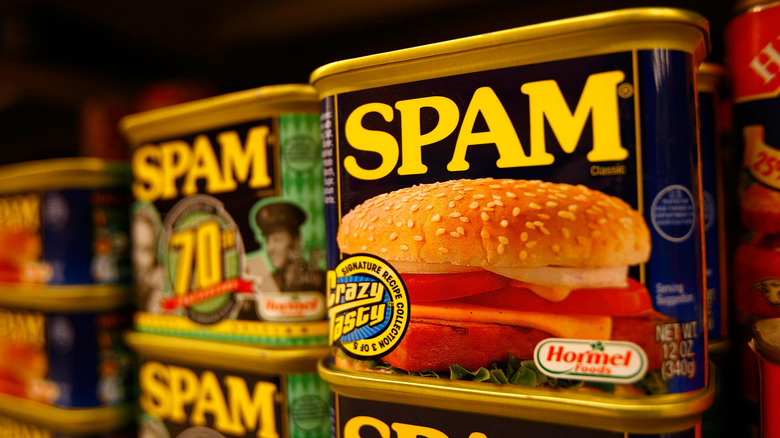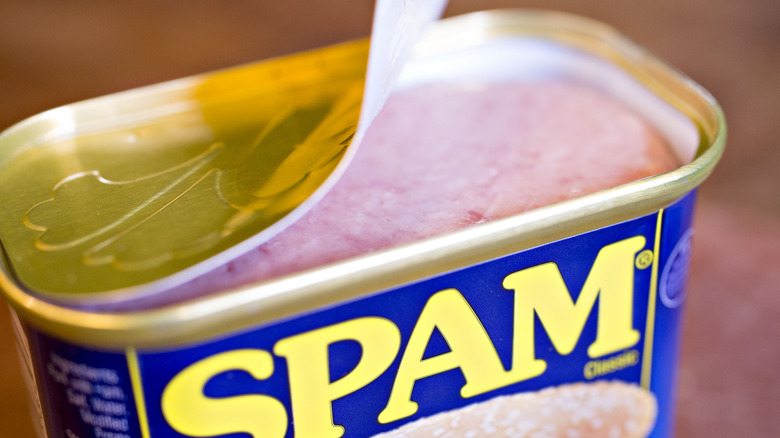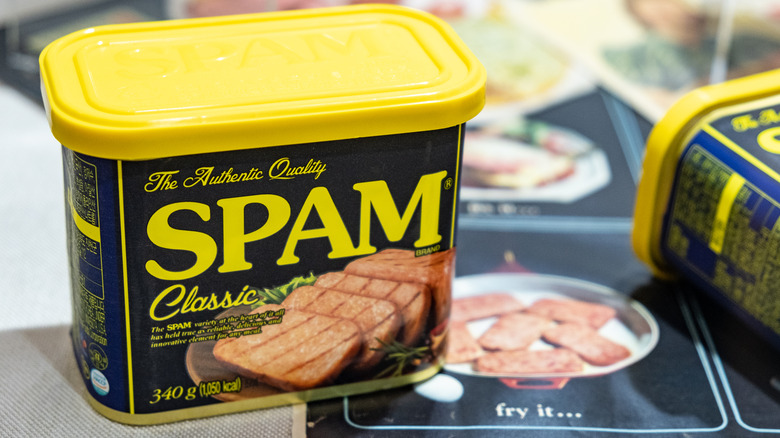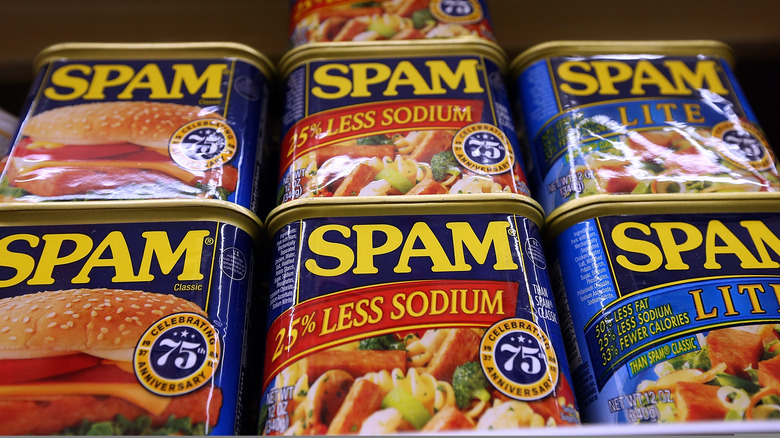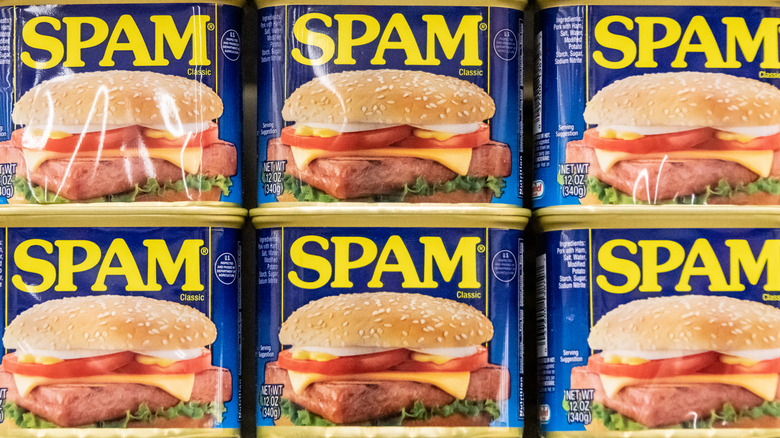What Exactly Is Spam And How Is It Made?
We may receive a commission on purchases made from links.
Spam (or SPAM, as its officially sold and labeled), is one of the great mysteries of the grocery store canned goods aisle. With an ineffable reputation for being America's "mystery meat" of choice, it's safe to say if you're reading this you probably don't quite know what it is. And there's no shame in that; most of us don't know anything about this iconic American canned food. If you do, you either love it or hate it — when it comes to Spam there's no in-between. But just what is this product exactly, and why is it so polarizing?
Perhaps it comes from the association with junk email, but any misinformation about Spam's questionability is straight ignorance and is counter to the truth. Since the 1930s, the Hormel corporation has been pretty straightforward about what goes into the can and how Spam is made. In fact, there is loads of information out there as to how and why Spam got developed and the product's place in American history.
What is in Spam?
You can't explain Spam without first digging into what's in the name. While it is said to have come from "spiced" and "ham," that has been disproven or changed with time due to the fact that the meat product doesn't contain spices or ham. Another prevailing, and more accurate, theory is that the name is an acronym for "shoulder of pork and ham," which are the primary ingredients, however, according to the company, Kenneth Daigneau is credited for giving the new product its name instead.
The ingredients on the can actually haven't changed all that much since it was launched. The recipe includes six ingredients: pork shoulder with ham meat, water, salt, potato starch, sugar, and sodium nitrate. Up until 2009, it was only five, but Hormel began adding potato starch to make the cooked meat look more appealing.
What does Spam taste like?
Due to it boiling down to a mixture of pork products with preservatives, it is safe to say that Spam tastes a lot like pork, although, in terms of texture and sodium content, it's similar to canned corned beef. A serving of the canned product contains 790 milligrams of sodium, which is a third of the daily recommended and just generally a massive amount of salt for one serving of meat. Which is to say, Spam tastes pretty salty as well.
So what you see is what you get with this canned meat: highly processed meat that is therefore high in salt and fat content, making for a rich and salty meal. It makes sense why, people either love it or find it utterly off-putting. Perhaps this is why in the 1960s, Hormel began leaning into marketing Spam as more of a "sometimes-food" side dish instead of the center of a meal.
When was Spam first made?
Spam debuted in 1937 and millions of cans were sent to US soldiers during World War II. By the end of the 1940s, it was one of Hormel's top products and would go on to determine the company's bottom line each year for decades to come.
Julius Zillgitt is credited by food historians as the employee who was responsible for coming up with the idea of the original 12-ounce can size. The vacuum-packed sealing method supposedly took years to invent, according to Jay Hormel, but it was one of the most important parts of the project. Without it, the meat couldn't stay sealed and safe to eat.
The process was mostly tried and true, as Spam remains as a mostly unchanged product over the years. However, there are a handful of ways Hormel's iconic canned meat has evolved since World War II.
How is Spam made today?
The process of manufacturing Spam is key to both its integrity and shelf-life, but also its very nature as a food product. Naturally, it hasn't changed much over the years. It's worth noting that the debut of Spam coincided with Hormel's big discovery: in order to vacuum seal and cook a meat product in a can without producing excess juices, the meat must also be mixed in a vacuum. Once this was discovered, a new luncheon meat was born.
After the meat is ground and canned, the innovative part of the process begins. Thousands at a time, rows of sealed cans of Spam head to a 6-story-tall hydrostatic cooker. Here, they can be cooked without having to remove the meat from its receptacle. In a 2-hour span, 66,000 cans will go through one of these machines. It is then cooled, labeled, and — after a mandatory 10-day waiting period — the cans are shipped out to retailers worldwide.
How has Spam changed over the years?
As we mentioned, in 2009 Spam turned from a simple five-ingredient recipe into six with the addition of potato starch. Prior to this addition, Spam was known for a layer of gelatin that would form on top after it was cooked in the can. This change made a more aesthetically-appealing product, which, in turn, led to a long period of year-over-year growth.
When it was first produced, Hormel provided its own meat for Spam, however, this is no longer the case. The USDA requires each batch to be examined to ensure the proper amount of pork shoulder to ham ratio is used.
In 1962, Hormel added a smaller can to the lineup, doubling down on a feature that made the product so desirable in the first place. The 12-ounce can was joined on the shelf by a smaller 7-ounce can meant to serve single people and smaller families. In 1972, Spam with cheese chunks and smoke-flavored product was introduced, and the '90s saw the launch of Spam-Lite and reduced fat options.
Today, there are a dozen varieties of Spam sold in stores that range from healthier variations like 25% Less Sodium to the more daring maple and jalapeño flavors. And we will never forget the time Hormel tried Pumpkin Spice edition Spam, which is much more appetizing than it sounds.
Spam lasts a long time, here's why
The process of making Spam is integrally tied to the reason it lasts so long. For starters, we must go back to the origins yet again. It was made to be shipped overseas and therefore was always intended to last a long time — from week-long journeys to being stored for months when stockpiling food in colder and harsher weather months.
Due to the conditions under which the product was first manufactured, Spam is built to last. Over the years, ensuring that the baseline didn't drop meant quality assurance of the highest degree was required. This includes weekly taste tests, bacteria testing, and a routine requirement that one out of every 1,000 cans be subjected to a 100-degree Fahrenheit heat test to see if the can bulges, indicating the meat was improperly cooked or stored. All of this is to ensure that Spam has the long-lasting quality for which it's known.
How many cans of Spam have been sold?
So, after all of that, just how popular is Spam? How does this polarizing tin of meat hold up in the hierarchy of Hormel's best-selling products? As it turns out, lifetime sales of Spam reflect that it's more than worthy of this level of investigation.
In terms of lifetime sales, as of the product's 85th birthday in 2022, Spam has sold over 9 billion units. This includes all 15 varieties of Spam that are available in the 44 countries that the Hormel product is sold. All in all, that's more cans of Spam sold than people currently living on this planet. While it is true that this accounts for sales, it might not account for the sheer amount of Spam produced and eaten by Americans at home and overseas, especially during wartime.
Where in the world is Spam the most popular?
Over the years, Spam has spread into cultural cooking and regional dishes from all over the world. Of all parts of America, this turns out to be the most true in Hawaii, where Spam is especially popular. Today, Korea is the world's second-largest consumer of Spam behind the US.
After World War II and into the 1960s especially, Spam was popular in Hawaii and the Asian Pacific nations of Japan and Korea due to widespread economic factors. At the time, the United States restricted deep-sea fishing in Hawaii to such a degree that Spam became a primary protein for many island citizens.
Over the years, immigration from Japan to Hawaii led to even more Spam creations, such as Spam musubi, a Hawaiian version of the handheld rice and seaweed dish onigiri. If you go to a Hawaiian dinner you will see the meat pop up as an option for everything from fried rice to omelets.
